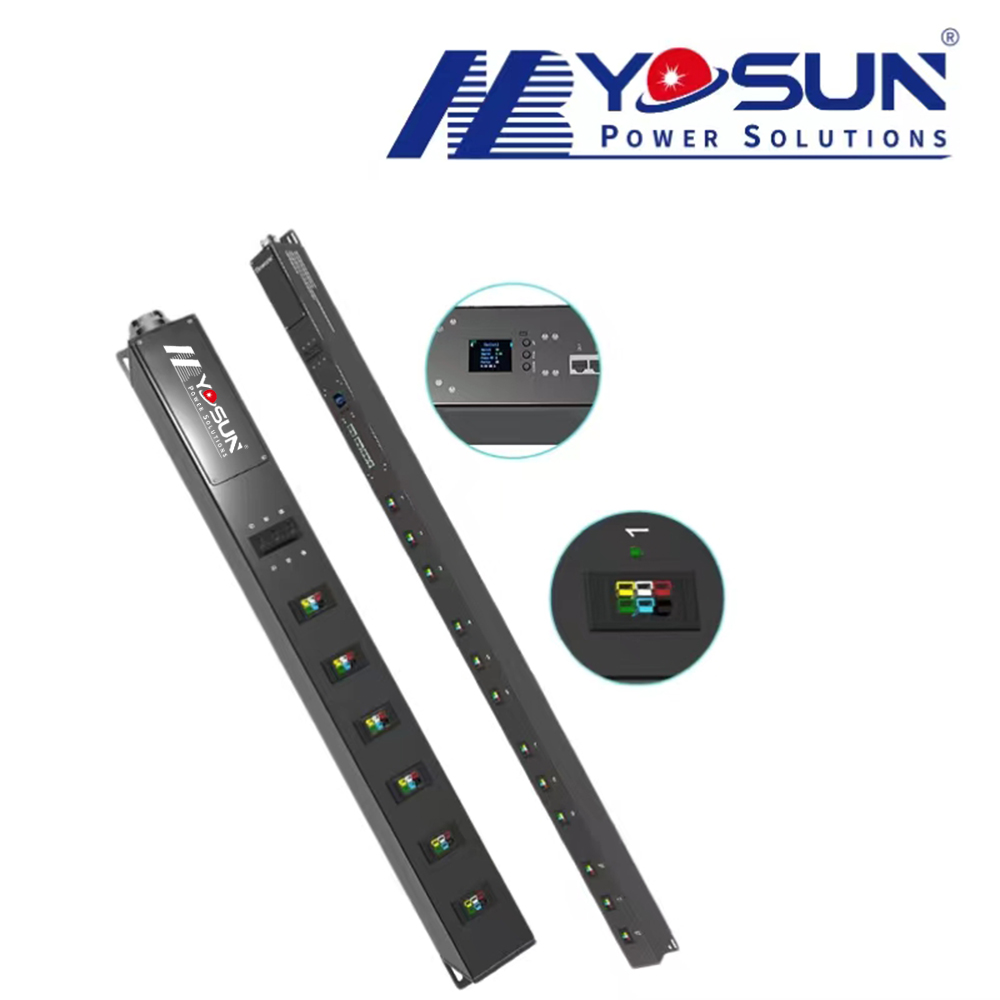
Power distribution units (PDUs) play a critical role in managing electricity within IT environments. A Smart PDU goes beyond basic power distribution by offering advanced features like monitoring and control. It allows you to track power usage, manage outlets remotely, and optimize energy efficiency. On the other hand, basic PDUs provide straightforward power delivery without additional functionalities. Your choice between these two depends on your operational needs, budget, and the complexity of your infrastructure. Understanding their differences helps you make informed decisions for your setup.
Key Takeaways
- Smart PDUs offer advanced features like real-time monitoring and remote management, making them ideal for complex IT environments.
- Basic PDUs provide straightforward power distribution at a lower cost, suitable for small offices or non-critical systems.
- Evaluate your infrastructure complexity: choose a Basic PDU for simple setups and a Smart PDU for larger, dynamic environments.
- Consider your budget: Basic PDUs are cost-effective, while Smart PDUs provide greater value through enhanced functionality.
- Plan for future growth: Smart PDUs offer scalability and flexibility, essential for expanding IT infrastructures.
- Focus on energy efficiency: Smart PDUs help track and reduce energy consumption, supporting sustainability initiatives.
What Are Basic PDUs?
Definition and Primary Function
A Basic PDU, or Power Distribution Unit, serves as a straightforward device for distributing electrical power to multiple devices. It acts as a central hub, ensuring that power reaches your equipment efficiently and reliably. Basic PDUs lack advanced features like monitoring or remote management. Their primary function is to deliver consistent power to connected devices without interruptions.
You can think of a Basic PDU as a power strip designed for IT environments. It provides multiple outlets, allowing you to connect servers, networking equipment, or other hardware. These units focus solely on power distribution, making them simple yet effective tools for managing electricity in less complex setups.
Common Use Cases
Basic PDUs are ideal for environments where simplicity and cost-effectiveness are priorities. They work well in scenarios where advanced monitoring or control features are unnecessary. Here are some common use cases:
- Small Offices or Home Labs: If you manage a small IT setup, a Basic PDU offers an affordable solution for powering your devices.
- Non-Critical Systems: For equipment that doesn’t require constant monitoring or remote management, Basic PDUs provide reliable power distribution.
- Temporary Installations: In temporary setups like trade shows or testing environments, Basic PDUs offer a quick and easy way to distribute power.
- Budget-Conscious Projects: When cost is a significant factor, Basic PDUs deliver essential functionality without additional expenses.
By focusing on simplicity, Basic PDUs meet the needs of users who prioritize reliability over advanced features. They are a practical choice for straightforward power management tasks.
What Are Smart PDUs?

Definition and Advanced Features
A Smart PDU, or Power Distribution Unit, takes power management to the next level. It not only distributes electricity but also provides advanced features that enhance control and monitoring. Unlike basic PDUs, a Smart PDU allows you to track power usage in real time. It offers tools to monitor energy consumption, environmental conditions, and device performance. These features help you optimize energy efficiency and prevent potential issues.
Smart PDUs often include remote management capabilities. You can control individual outlets, reboot devices, or shut down equipment from anywhere. This functionality proves invaluable in large or distributed IT environments. Many Smart PDUs also integrate with software platforms, enabling you to analyze data and generate reports. These insights support better decision-making and improve operational efficiency.
Common Use Cases
Smart PDUs excel in environments where advanced monitoring and control are essential. They cater to IT setups that demand precision and scalability. Here are some common scenarios where a Smart PDU becomes indispensable:
- Data Centers: In large-scale operations, Smart PDUs help you monitor power usage across multiple racks. They ensure efficient energy distribution and reduce downtime risks.
- Remote IT Facilities: For locations without on-site staff, Smart PDUs allow you to manage power remotely. You can troubleshoot issues and maintain uptime without physical intervention.
- High-Density Environments: In setups with numerous devices, Smart PDUs provide detailed insights into power consumption. This helps you balance loads and avoid overloading circuits.
- Energy-Conscious Organizations: If sustainability is a priority, Smart PDUs enable you to track and reduce energy usage. They support green initiatives by identifying inefficiencies.
- Critical Systems: For equipment that requires constant monitoring, Smart PDUs offer real-time data and alerts. This ensures that you can address problems before they escalate.
By offering advanced features, Smart PDUs empower you to manage power with greater precision. They are ideal for complex environments where reliability and efficiency are top priorities.
Key Differences Between Smart and Basic PDUs
Feature Comparison
Smart PDUs and basic PDUs differ significantly in their features. A basic PDU focuses solely on power distribution. It ensures that electricity reaches your devices without interruptions. However, it does not provide any monitoring or control capabilities. This simplicity makes it easy to use but limits its functionality.
A Smart PDU, on the other hand, offers advanced features that enhance power management. It allows you to monitor power usage in real time. You can track energy consumption, check environmental conditions, and even control individual outlets remotely. These features help you optimize energy efficiency and maintain better control over your IT infrastructure. Smart PDUs also integrate with software tools, enabling you to analyze data and generate reports for improved decision-making.
If you need basic power delivery, a basic PDU will meet your needs. If you require detailed insights and remote management, a Smart PDU is the better choice.
Cost and Complexity
Cost is another key difference between Smart PDUs and basic PDUs. A basic PDU is more affordable. Its simple design and lack of advanced features make it a cost-effective option for straightforward setups. You can rely on it for reliable power distribution without worrying about additional expenses.
A Smart PDU comes with a higher price tag. Its advanced features, such as monitoring and remote control, increase its cost. Additionally, using a Smart PDU may require more technical knowledge. You might need to configure software or integrate it with existing systems. This added complexity can be a challenge if you are unfamiliar with such tools.
When deciding between the two, consider your budget and technical expertise. A basic PDU is ideal for cost-conscious projects. A Smart PDU is worth the investment if you need advanced capabilities.
Scalability and Flexibility
Scalability and flexibility are crucial factors in IT environments. A basic PDU works well in small or static setups. It provides reliable power distribution but lacks the ability to adapt to growing or changing needs. If your infrastructure expands, you may need to replace or upgrade your basic PDU.
A Smart PDU excels in scalability and flexibility. It supports dynamic IT environments where growth and change are constant. You can monitor and manage multiple devices across different locations. Its advanced features allow you to adjust power distribution as your needs evolve. This adaptability makes it a valuable tool for long-term use.
If you expect your setup to grow, a Smart PDU offers the flexibility you need. For smaller, fixed environments, a basic PDU remains a practical choice.
When to Choose a Smart PDU vs. a Basic PDU
Factors to Consider
Choosing between a Smart PDU and a basic PDU depends on your specific needs and priorities. To make the right decision, you should evaluate several key factors:
-
Infrastructure Complexity
Assess the size and complexity of your IT setup. A basic PDU works well for small or straightforward environments. If your infrastructure includes multiple racks or remote locations, a Smart PDU provides better control and monitoring.
-
Budget Constraints
Determine how much you are willing to spend. A basic PDU offers a cost-effective solution for simple power distribution. If your budget allows for advanced features, a Smart PDU delivers greater value through its monitoring and management capabilities.
-
Operational Requirements
Identify the level of control and monitoring you need. A basic PDU handles power distribution efficiently but lacks advanced functionality. A Smart PDU supports real-time monitoring, remote management, and energy optimization, which are essential for critical systems.
-
Future Growth
Consider whether your IT environment will expand. A basic PDU may suffice for static setups. If you anticipate growth, a Smart PDU offers scalability and flexibility to adapt to changing requirements.
-
Energy Efficiency Goals
Evaluate your commitment to energy efficiency. A Smart PDU helps you track and reduce energy consumption. It supports sustainability initiatives by identifying inefficiencies and optimizing power usage.
Smart PDUs and basic PDUs address different needs in power management. Basic PDUs provide a simple and cost-effective solution for straightforward setups. They work well when advanced features are unnecessary. Smart PDUs, however, deliver enhanced functionality for complex environments. They offer monitoring, remote control, and scalability.
To choose the right PDU, evaluate your budget, operational needs, and future growth plans. Consider whether you need simplicity or advanced capabilities. By aligning your choice with your requirements, you can ensure efficient and reliable power management for your IT infrastructure.
FAQ
What is the primary purpose of a PDU?
A Power Distribution Unit (PDU) ensures that electricity is distributed efficiently to multiple devices. It acts as a central hub for power delivery, making it essential for IT environments where multiple pieces of equipment need reliable power.
How does a Smart PDU differ from a Basic PDU?
A Smart PDU offers advanced features like real-time monitoring, remote management, and energy tracking. A Basic PDU focuses solely on distributing power without additional functionalities. If you need detailed insights or remote control, a Smart PDU is the better choice.
Are Smart PDUs worth the higher cost?
Smart PDUs provide value through their advanced features. They help you monitor power usage, optimize energy efficiency, and manage devices remotely. If your setup requires these capabilities, the investment in a Smart PDU pays off in the long run.
Can I use a Basic PDU in a data center?
You can use a Basic PDU in a data center, but it may not meet all your needs. Data centers often require advanced monitoring and scalability, which Smart PDUs provide. Basic PDUs work better in smaller or less complex setups.
Do Smart PDUs require technical expertise to operate?
Smart PDUs may require some technical knowledge, especially for configuring software or integrating them with existing systems. However, many manufacturers provide user-friendly interfaces and support to simplify the process.
Which PDU is better for small businesses?
For small businesses with straightforward IT setups, a Basic PDU offers a cost-effective solution. If your business plans to grow or needs advanced monitoring, a Smart PDU provides the flexibility and features to support future expansion.
Can Smart PDUs help reduce energy costs?
Yes, Smart PDUs track energy consumption and identify inefficiencies. By analyzing this data, you can optimize power usage and reduce energy costs. They are especially useful for organizations with sustainability goals.
Are there any risks associated with using a Basic PDU?
Basic PDUs lack monitoring and control features, which can make it harder to detect issues like power overloads or inefficiencies. In critical environments, this limitation could lead to downtime or equipment damage.
How do I decide between a Smart PDU and a Basic PDU?
Evaluate your infrastructure complexity, budget, and operational needs. If you need simple power distribution, choose a Basic PDU. For advanced monitoring, remote management, and scalability, opt for a Smart PDU.
Can I upgrade from a Basic PDU to a Smart PDU later?
Yes, you can upgrade to a Smart PDU as your needs evolve. However, consider your future growth plans when making your initial purchase. Investing in a Smart PDU upfront may save you time and effort in the long term.
Post time: Dec-29-2024






